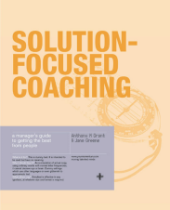Solution-focused Coaching – managing people in a complex world: Jane Greene and Anthony M Grant
 The book is written for the manager who wants to manage and develop his/her people by using coaching techniques. The introduction says “Coaching is about creating positive directed change. It is about helping people to develop their potential. Managers can use coaching to enhance and increase the performance of individuals and teams.”
The book is written for the manager who wants to manage and develop his/her people by using coaching techniques. The introduction says “Coaching is about creating positive directed change. It is about helping people to develop their potential. Managers can use coaching to enhance and increase the performance of individuals and teams.”
Of course, the coaching approaches and techniques described in the book are every bit as useful to executive coaches.
Key themes and ideas
Solution-focused coaching focuses on the potential solution, not the problem. This approach guides people to use their past experience of getting it right, and their experience of coping and succeeding, to help them to find a solution to a difficult situation. The authors describe the solution-focused approach as a process of identifying:
- The goal
- The positive outcome wanted
- The change that needs to be made
- Previous experience of coping in the past
- Strengths and successes
- How to do more of what works
- Any exceptions to the problem
- How to get more of those exceptions to happen.
Any of you who have used the Kepner-Tregoe approach to problem solving will find some commonality here. The solution-focused approach is a superb complement to the Kepner-Tregoe logical, step-by-step model.
Useful gems
- Coaches will sometimes make the mistake of thinking that the coaching client has already moved to the “taking action” stage of making a change when, actually, he/she is still contemplating whether to make the change at all. The coach needs first to invest time in helping the client to weigh up the advantages and disadvantages of making the change (tools to do this are in the Motivational Interviewing book by Miller and Rollnick which is also reviewed on this website)
- The book introduces lots of coaching tools and presents them clearly and simply. This is a good resource for inexperienced coaches and line managers wanting to start coaching their staff. If I have a quibble here, it’s that the book makes a number of statements that jar with me (developmental coaching is “…the most sophisticated type of coaching.” Coaching sessions must finish with a written action plan. “If it’s not written down, it’s not coaching.”). However, the collection of basic tools is useful
- There are some nice questionnaires starting on p133 (drawn from the work of Grant and Cavanagh) to help managers to assess their coaching skills. These could work just as well for other coaches
- I liked the description of the house of change. This uses work from cognitive-behavioural therapy and says that, for change to work, the client needs to work on four separate life domains:
- Thoughts
- Feelings
- Behaviour
- The situation or environment
Why I rate this book
- The solution-focussed approach is a superb reminder not to allow the coaching problem to consume all the coaching attention
- The book is peppered with brief summaries of a wide range of research studies to support the authors’ contentions
- Any tool or technique described in the book is described very simply and clearly
- The book gives clear guidance on the skills and context needed for successful coaching
- There are lots of relevant quotes
- It’s a useful stepping off point – if you like one of the techniques described, the book tells you who developed it and where you can find more information.
 Visit Amazon for more reviews, and a competitive price. Solution-focused Coaching – managing people in a complex world, Jane Greene and Anthony M Grant.
Visit Amazon for more reviews, and a competitive price. Solution-focused Coaching – managing people in a complex world, Jane Greene and Anthony M Grant.
Paperback: 208 pages
Publisher: Chartered Institute of Personnel and Development; 1 edition (1 Mar 2006)
ISBN-10: 184304028X
ISBN-13: 978-1843040286
Dimensions: 21.1 x 16.9 x 1.7 cm
 Share Article
Share Article